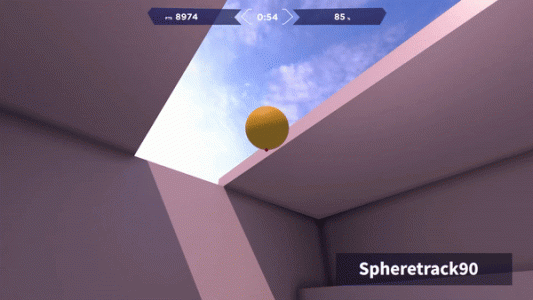Navigation
Install the app
How to install the app on iOS
Follow along with the video below to see how to install our site as a web app on your home screen.
Note: This feature may not be available in some browsers.
More options
You are using an out of date browser. It may not display this or other websites correctly.
You should upgrade or use an alternative browser.
You should upgrade or use an alternative browser.
LG 32GS95UE – OLED 31.5″ with 4K @ 240Hz and 1080p @ 480Hz Support - The death knell of LCD panels
- Thread starter tongshadow
- Start date
wait til 2025 for rgb oled? I just wanted a change from my 48CXCongrats. I still have my Amazon order but questioning whether I should bother with this monitor and if I do getting from LG instead would make it $110 less expensive.
MistaSparkul
2[H]4U
- Joined
- Jul 5, 2012
- Messages
- 3,524
wait til 2025 for rgb oled? I just wanted a change from my 48CX
RGB OLED isn't confirmed, it's just being considered. Seeing how LG has been so reliant on the white subpixel for almost 10 years now, I find it hard to believe they will actually move away from it. Would love to be wrong though as a RGB OLEDs does sound neat!
tongshadow
Limp Gawd
- Joined
- Jun 20, 2023
- Messages
- 147
I mean, so far the roadmap has been true, and I remember doubters last year saying "DUDE, THERE'S NO WAY THEY'LL MAKE A 32" 4K/240HZ AND A 480HZ OLED, IT'S TOO EARLY MAN". And yet, here we are.
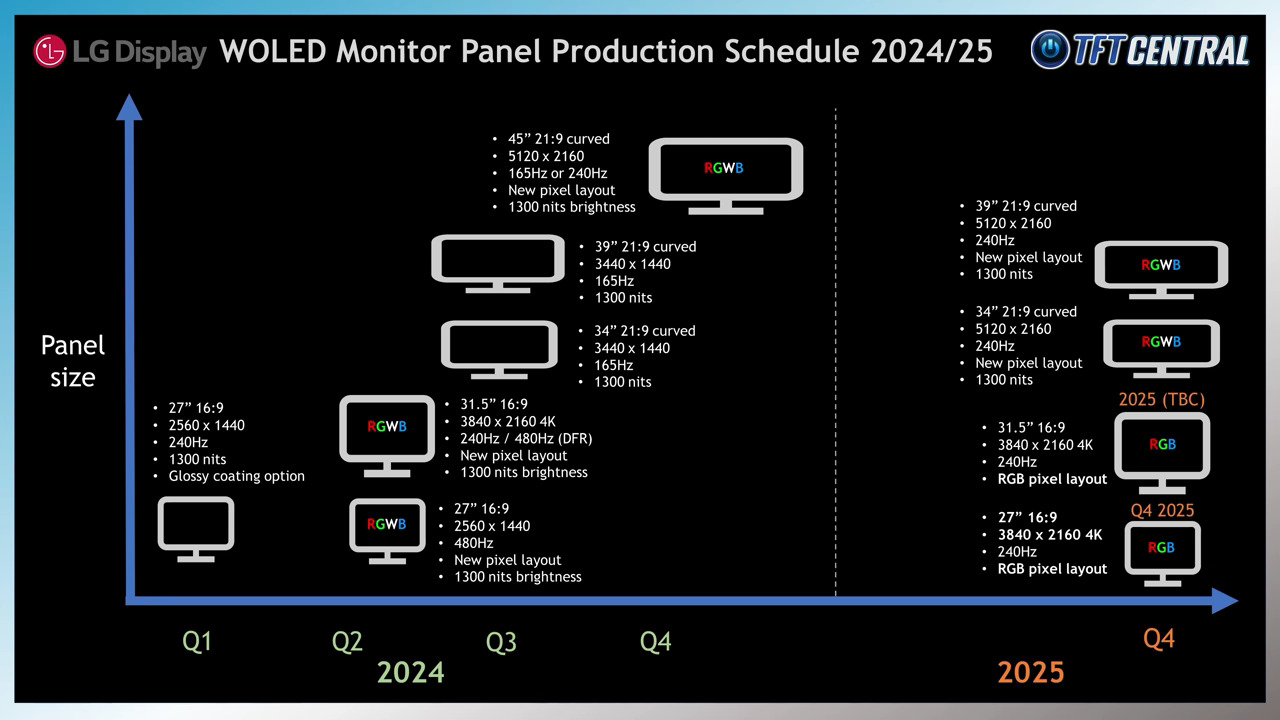

This was the dream endgame to replace my C2 until it hit me that LG's not going to be doing full glossy on these. What a waste. Will have to wait and see what Samsung Display has in store for that size/resolution in the next couple of years.
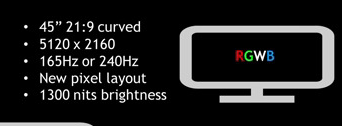

MistaSparkul
2[H]4U
- Joined
- Jul 5, 2012
- Messages
- 3,524
I mean, so far the roadmap has been true, and I remember doubters last year saying "DUDE, THERE'S NO WAY THEY'LL MAKE A 32" 4K/240HZ AND A 480HZ OLED, IT'S TOO EARLY MAN". And yet, here we are.
View attachment 639812
And what's missing on that roadmap? Oh that's right....the NITS. Again LG has relied on white subpixel for too long so whether or not they can suddenly just drop it in 1 year while still doing 1300 nits I am doubtful. If it does come out next year without any brightness drop I will be impressed.
elvn
Supreme [H]ardness
- Joined
- May 5, 2006
- Messages
- 5,314
And what's missing on that roadmap? Oh that's right....the NITS. Again LG has relied on white subpixel for too long so whether or not they can suddenly just drop it in 1 year while still doing 1300 nits I am doubtful. If it does come out next year without any brightness drop I will be impressed.
Phosphorescent blue oled + MLA (micro lens array) could potentially make up for that if included. Fluorescent blue dies fast so is one of the reasons oleds had to be so conservative. MLA focuses everything brighter instead of dispersed as much through layers normally. However WOLED + both of those would prob be even brighter in effect so depends how you look at it.

https://www.digitaltrends.com/home-theater/what-is-pholed/
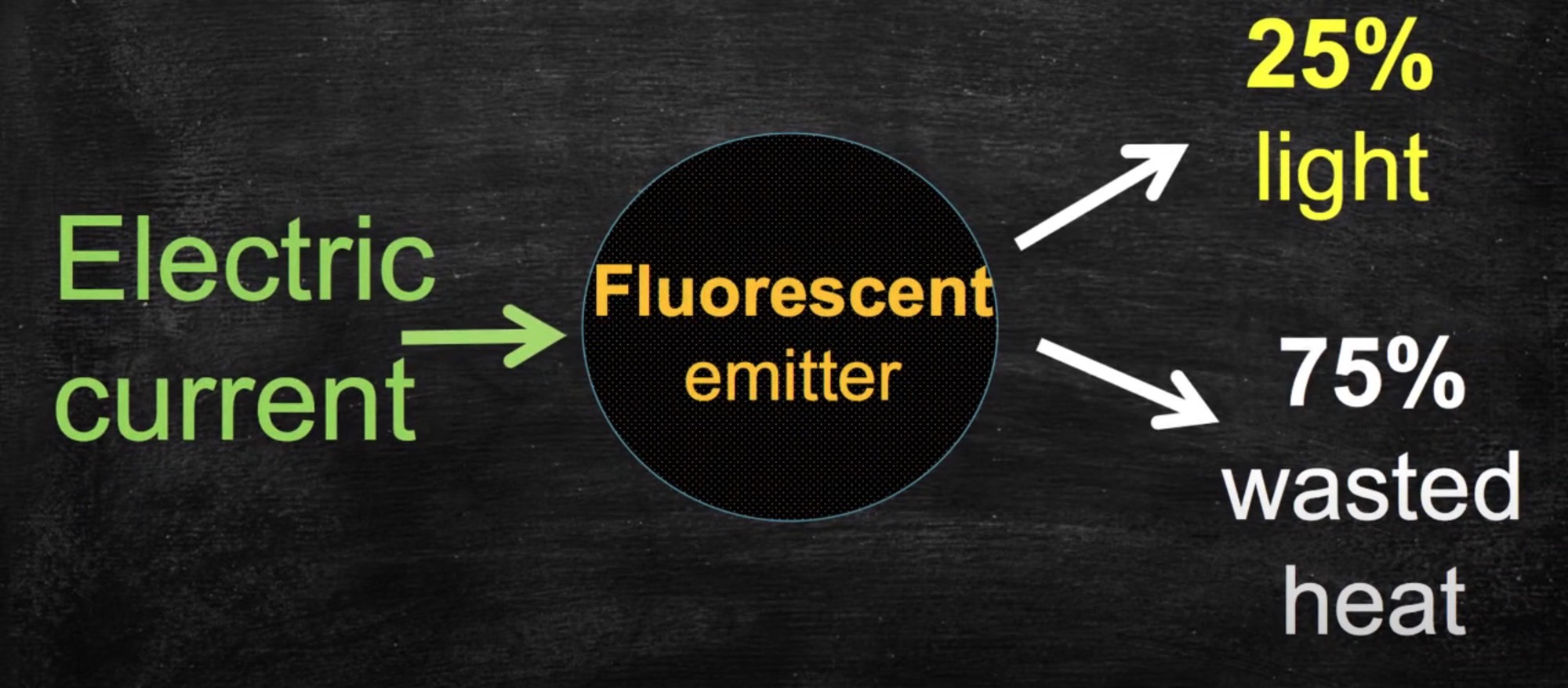
.The second, less common type of OLED is phosphorescent OLED. When phosphorescent OLED material (PHOLED) is energized, that light-to-heat ratio becomes far more efficient at creating light — nearly 100% light and zero heat.
While the ability to create stable and accurate red PHOLED happened in 2003, and green PHOLED in 2013, the goal of an equally high-performance blue PHOLED has remained out of reach. That presents a big hurdle for the TV world.
At the moment, red and green OLED materials are predominantly used in mobile phone-, tablet-, and laptop-sized displays. They very rarely show up in TV-sized panels (this very expensive, 24-inch Sony broadcast mastering monitor being among the exceptions). Blue OLED, on the other hand, is a foundational ingredient in both LG Display’s WOLED and Samsung Display’s QD-OLED panels.
In LG’s panels, blue OLED is mixed with yellow-green OLED to create full-spectrum white light (which is then processed by a color filter). Samsung’s QD-OLED uses blue OLED as its exclusive source of light for each pixel and then converts some of the blue light into red and green light using quantum dots.
MistaSparkul
2[H]4U
- Joined
- Jul 5, 2012
- Messages
- 3,524
Phosphorescent blue oled + MLA (micro lens array) could potentially make up for that if included. Fluorescent blue dies fast so is one of the reasons oleds had to be so conservative. MLA focuses everything brighter instead of dispersed as much through layers normally. However WOLED + both of those would prob be even brighter in effect so depends how you look at it.
View attachment 639877
https://www.digitaltrends.com/home-theater/what-is-pholed/
View attachment 639875
.
Samsung should be first to PHOLED so once they get a product out then we can expect LG to follow.
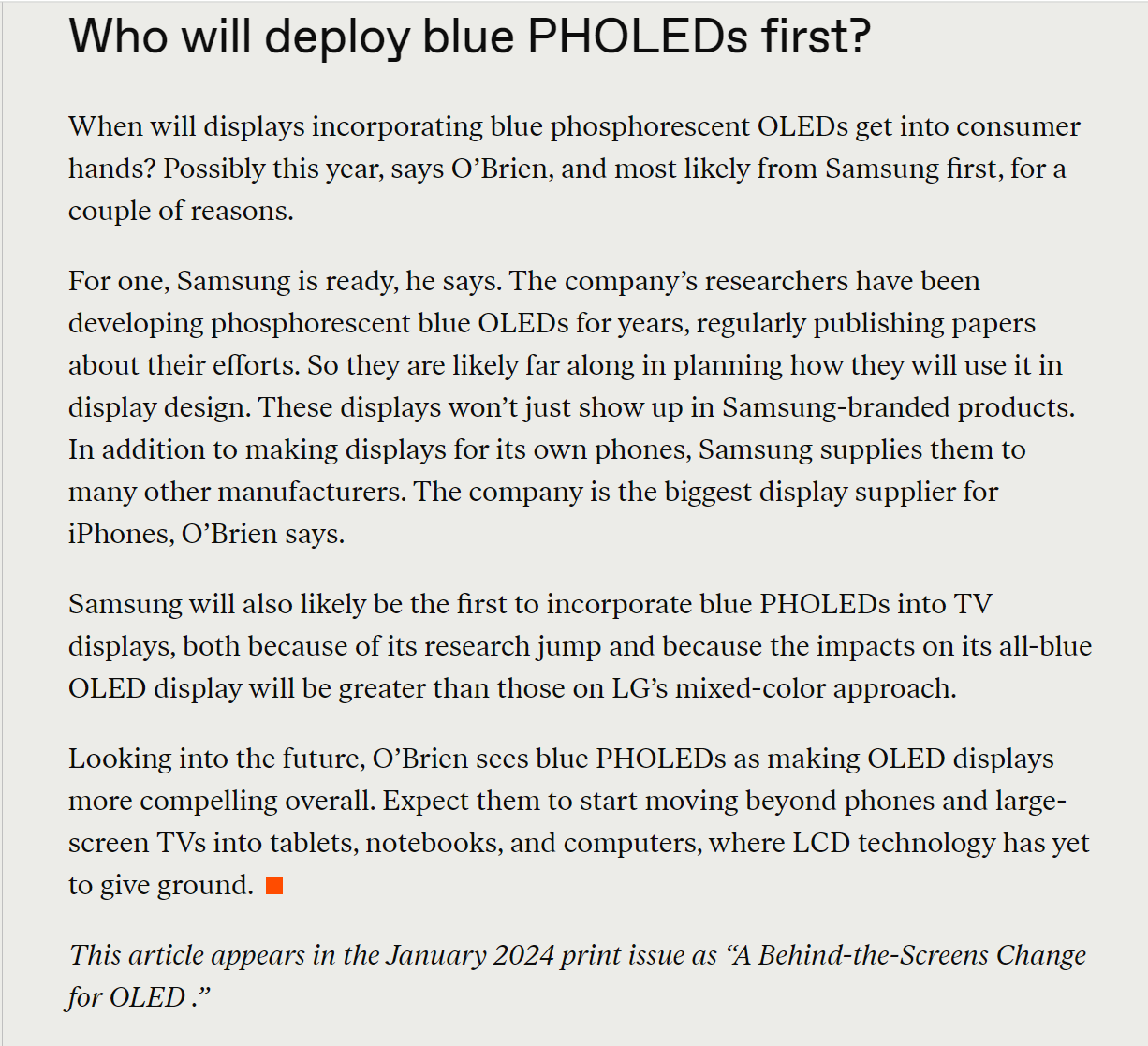
tongshadow
Limp Gawd
- Joined
- Jun 20, 2023
- Messages
- 147
We know better than to trust manufacturer's numbers, but it's close enough at ~1200nits on Asus' monitors:And what's missing on that roadmap? Oh that's right....the NITS. Again LG has relied on white subpixel for too long so whether or not they can suddenly just drop it in 1 year while still doing 1300 nits I am doubtful. If it does come out next year without any brightness drop I will be impressed.
https://tftcentral.co.uk/reviews/asus-rog-swift-pg34wcdm
MistaSparkul
2[H]4U
- Joined
- Jul 5, 2012
- Messages
- 3,524
We know better than to trust manufacturer's numbers, but it's close enough at ~1200nits on Asus' monitors:
https://tftcentral.co.uk/reviews/asus-rog-swift-pg34wcdm
....Did you not read what I said? lol. I said I am doubtful that LG can maintain the same brightness figures (whether that's 1300 or 1200 whatever) WITHOUT the white subpixel being present because they relied on it for so long. Why are you linking a monitor that has white subpixel?
tongshadow
Limp Gawd
- Joined
- Jun 20, 2023
- Messages
- 147
Ok, tell us the technical reason for it.....Did you not read what I said? lol. I said I am doubtful that LG can maintain the same brightness figures (whether that's 1300 or 1200 whatever) WITHOUT the white subpixel being present because they relied on it for so long. Why are you linking a monitor that has white subpixel?
MistaSparkul
2[H]4U
- Joined
- Jul 5, 2012
- Messages
- 3,524
Ok, tell us the technical reason for it.
There is no technical reason why they can't. Obviously at some point they will need to move beyond the white subpixel to compete better with QD OLED but like I said they have been using for like a decade now so will they be able to just drop it by next year? Maybe! I'm just doubtful.
MistaSparkul
2[H]4U
- Joined
- Jul 5, 2012
- Messages
- 3,524
i know this might not be relevant but LG now has a promo for their ultrawide 240hz gaming oleds 34 39 and 45, 100 dollars off plus 200 prepaid mastercard... good deal?
That makes them what, $999? If so then yeah I guess because they don't really have competition. The QD OLED UW are either 34 or 49 but not 39 or 45.
CookieFactory
Limp Gawd
- Joined
- May 17, 2006
- Messages
- 357
nm got the 15% off which is 210 dollars, i'll take it. came out to a total of 1261.39 with my local tax added.
Preorders are expected to start shipping the week of Mon, Apr 15
How'd you get the coupon?
Astral Abyss
2[H]4U
- Joined
- Jun 15, 2004
- Messages
- 3,066
I really wish they were 3840x1600, like my good ol 38GN950. Or 5120x2160... even better. I'd upgrade to the 39" if it was. Samsung or LG tech, don't care which. I wasn't a big fan of the overblown 800R curve on the previous 45" either. It's a bit ridiculous. Sad to see they kept it the same.That makes them what, $999? If so then yeah I guess because they don't really have competition. The QD OLED UW are either 34 or 49 but not 39 or 45.
These 2024 LG ultrawides are basically placeholders until next years increased resolution.
MistaSparkul
2[H]4U
- Joined
- Jul 5, 2012
- Messages
- 3,524
I really wish they were 3840x1600, like my good ol 38GN950. Or 5120x2160... even better. I'd upgrade to the 39" if it was. Samsung or LG tech, don't care which. I wasn't a big fan of the overblown 800R curve on the previous 45" either. It's a bit ridiculous. Sad to see they kept it the same.
These 2024 LG ultrawides are basically placeholders until next years increased resolution.
That 45" 5120x2160 240Hz UW really looks tempting. But my bet is that it's gonna be matte and I'm already on a glossy QD OLED so I'm not sure if it's worth switching over. UW is nice but from my experience with it, it's still not 100% supported in all cases.
It works.15% off code is heca(zip code) so heca11111 or whatever your zipcode is, if your zip code doesn't work try a zip code near you.
Astral Abyss
2[H]4U
- Joined
- Jun 15, 2004
- Messages
- 3,066
The MSI is glossy? I thought it was the standard matte finish?That 45" 5120x2160 240Hz UW really looks tempting. But my bet is that it's gonna be matte and I'm already on a glossy QD OLED so I'm not sure if it's worth switching over. UW is nice but from my experience with it, it's still not 100% supported in all cases.
MistaSparkul
2[H]4U
- Joined
- Jul 5, 2012
- Messages
- 3,524
The MSI is glossy? I thought it was the standard matte finish?
Nope that would be Samsung, or any of the monitors using LG WOLED.
CookieFactory
Limp Gawd
- Joined
- May 17, 2006
- Messages
- 357
15% off code is heca(zip code) so heca11111 or whatever your zipcode is, if your zip code doesn't work try a zip code near you.
Great, thanks. I'm in the market for a new a new monitor setup and had recently placed an order fir the MSI MPG321UR QD 32" but I just cancelled that and pre-ordered this.
MistaSparkul
2[H]4U
- Joined
- Jul 5, 2012
- Messages
- 3,524
I'm not sure how this guy got a review sample but he probably won't be getting anymore in the future lol.


Astral Abyss
2[H]4U
- Joined
- Jun 15, 2004
- Messages
- 3,066
Especially with the grammar of a 12 year old phone addict.I'm not sure how this guy got a review sample but he probably won't be getting anymore in the future lol.
View attachment 640432
Armenius
Extremely [H]
- Joined
- Jan 28, 2014
- Messages
- 42,162
The HP coming out in August supposedly has a glossy coating.I don't think any manufacturer is going to give us glossy OLED monitors. (Dough doesn't count) I'd swap my 27GR95QE in a second if I could find a glossy OLED monitor. It's just not likely to happen.
Correct. There are a few out now from Alienware, MSI and Asus.I think most of the upcoming qd oled 32” 240hz monitors are listed as glossy, but the corresponding woleds are matte.
Also want full glossy..... after using the 48C1 for a few years, I can't leave the glossy realm! it just goes so incredibly well with oled panels.... I'm actually kindof shocked more companies aren't going glossy versions of these new oled panels...This was the dream endgame to replace my C2 until it hit me that LG's not going to be doing full glossy on these. What a waste. Will have to wait and see what Samsung Display has in store for that size/resolution in the next couple of years.
View attachment 639855
tongshadow
Limp Gawd
- Joined
- Jun 20, 2023
- Messages
- 147
A proper review from the Dual mode monitor, optimum is very credible. And yes, it is insane as he says.
View: https://www.youtube.com/watch?v=0aJLTx12UQM
View: https://www.youtube.com/watch?v=0aJLTx12UQM
Optimum knows his e-sports displays and he seems to think its very, very good in that 480Hz mode. Looks like LG might have a winner on their hands for those that find this feature useful. I, sadly, do not. That and I really, really prefer full glossy/glass.
elvn
Supreme [H]ardness
- Joined
- May 5, 2006
- Messages
- 5,314
A proper review from the Dual mode monitor, optimum is very credible. And yes, it is insane as he says.
View: https://www.youtube.com/watch?v=0aJLTx12UQM
Optimum knows his e-sports displays and he seems to think its very, very good in that 480Hz mode. Looks like LG might have a winner on their hands for those that find this feature useful. I, sadly, do not. That and I really, really prefer full glossy/glass.
Neat but Higher fpsHz is not a 1:1 relationship to online-latent gaming servers' processing and their delivered biased (in different ways depending on the coding) interpolated results, though it is marketed as if it is. LAN gaming, LAN competitions, and testing on a lan or locally vs bots is a different animal. In fact for example, it's been related in articles that CS:go players have to recalibrate/adjust to how they play when they play on a LAN because the dynamics are so different. I doubt most people buying high hz screens are playing in lan competitions.
Higher fpsHZ like 240fpshz, 480Hz provided the fps is ranging into the max Hz numbers, will reduce your FoV movement blur of the entire game world (during mouse looking, movement-keying, controller panning) by 1/2 compared to 120fpsHz for 240fpsHz, and by 4 times compared to 120fpsHz for 480fpsHz which is a nice improvement aesthetically. Reduced blur might help a tiny bit competitively, identifying/aiming at targets with a little less blur during FoV movement at speed, but dropping to 1080p mode can make outlines worse so non-native isn't the best for that. The detail in 4k can be a benefit for far away enemies and happenings too. From the blur reduction aesthetic facet, you definitely wouldn't want to drop to 1080p compared to the aesthetic detail benefit of 4k, and on this screen 1080p being non native rez at that - so that wouldn't make any sense to do that for 480fpsHz from a picture quality standpoint as far as blur reduction goes.
Last edited:
It sounds like you're talking theory without watching his video with in person experience.Neat but Higher fpsHz is not a 1:1 relationship to online-latent gaming servers' processing and their delivered biased (in different ways depending on the coding) interpolated results, though it is marketed as if it is. LAN gaming, LAN competitions, and testing on a lan or locally vs bots is a different animal. In fact for example, it's been related in articles that CS:go players have to recalibrate/adjust to how they play when they play on a LAN because the dynamics are so different.
Higher fpsHZ like 240fpshz, 480Hz provided the fps at max, will reduce your FoV movement blur of the entire game world (during mouse looking, movement-keying, controller panning) by 1/2 compared to 120fpsHz at max though which is a nice improvement aesthetically (and might help a tiny bit competitively, identifying/aiming at targets with a little less blur during FoV movement at speed). From the blur reduction aesthetic facet, you wouldn't want to drop to 1080p though, non native rez at that - so that wouldn't make any sense to do that for 480fpsHz.
elvn
Supreme [H]ardness
- Joined
- May 5, 2006
- Messages
- 5,314
It sounds like you're talking theory without watching his video with in person experience.
I watched the video, one of the reasons I mentioned the outlines at 1080p being muddied specifically.
"Higher fpsHZ like 240fpshz, 480Hz provided the fps is ranging into the max Hz numbers, will reduce your FoV movement blur of the entire game world (during mouse looking, movement-keying, controller panning) by 1/2 compared to 120fpsHz for 240fpsHz, and by 4 times compared to 120fpsHz for 480fpsHz which is a nice improvement aesthetically. Reduced blur might help a tiny bit competitively, identifying/aiming at targets with a little less blur during FoV movement at speed, but dropping to 1080p mode can make outlines worse so non-native isn't the best for that. The detail in 4k can be a benefit for far away enemies and happenings too. From the blur reduction aesthetic facet, you definitely wouldn't want to drop to 1080p compared to the aesthetic detail benefit of 4k, and on this screen 1080p being non native rez at that - so that wouldn't make any sense to do that for 480fpsHz from a picture quality standpoint as far as blur reduction goes."
Last edited:
MistaSparkul
2[H]4U
- Joined
- Jul 5, 2012
- Messages
- 3,524
It sounds like you're talking theory without watching his video with in person experience.
Seriously lol. The higher Hz/fps isn't just about reducing input lag or motion clarity. For me, it is much easier to flick to and track targets at higher Hz/frame rates. Although the 480Hz mode on this monitor is useless for me since nothing I play would ever get anywhere near 480fps.
Attachments
Last edited:
If your point is it won't be as sharp as a native 1080p panel, I don't think anyone is confused otherwise. Optimum is a serious competitive player and is comfortable enough with its performance in the 1080p mode to stop using the $900 540hz 1080p he was using and move to a single monitor. That's pretty high praise regardless of how many theoretical numbers you can come up with.I watched the video, one of the reasons I mentioned the outlines at 1080p being muddied specifically.
Last edited:
elvn
Supreme [H]ardness
- Joined
- May 5, 2006
- Messages
- 5,314
Seriously lol. The higher Hz/fps isn't just about reducing input lag or motion clarity. For me, it is much easier to flick to and track targets at higher Hz/frame rates.
I love higher fpsHz. However I've always suspected that you'd get diminishing returns locally after 240fpsHz on the motion definition, motion articulation aspect (more dots per dotted line curve, more unique animation pages in an animation flip book that is flipping faster). For the blur reduction aspect, the sky is the limit to 1000fpsHz (or higher, but oled is theoretically capable of 1000Hz) though, so the more Hz (with the least tradeoffs) the better.
It seems like a very nice screen, and I can see where people would be happy with it. I just dislike when very high performance (locally) things are promoted as a 1:1 relationship to advantage in online gaming systems as they function now. Online games through servers are all lower rates (some very very low) and rubberbanding all of the time, it's just a matter of whether its a short enough rubberband for you to not notice it so much. Making the rubberband tinier and tinier locally isn't going to change the online latency, tick rates, biased interpolated results of the (online rather than LAN competition) game server's rubberband. Most testing of high fpsHz screens in online reviews showing the advantages is done locally or on a LAN, and often vs bots. I'm assuming your spheretrack was done locally in the same fashion, with the sphere being analogous to a bot.

Still it's pretty cool. Can you run a tracker similar to that which is running through a remote online game server's interpolation code? and get a report card readout of the % accuracy/cursor-hits delivered back to you? Then compare that to the local/LAN version.
The thing is, in online gaming server systems - when you see your cursor on the ball a certain % at the center of the ball, or how quickly you got your cursor onto the ball - it's not necessarily how the online server is processing the result back to you, or even where the ball exactly "was" in the first place at any given time during it's directional changes, according to the server's rates and the server's final process.. So even if you are tracking things better locally that doesn't translate 1:1 to the online clockwork. a.k.a. rubberbanding, temporal shift, etc.
I'm curious of what your 240fpsHz vs 480fpsHz blind testing results would be across days of testing just locally even,
but I wonder what your results would be with some system to record how accurate to the ball you were able to be (at least considering what you were seeing vs what the server processed) at 240fpsHz solid vs 480fpsHz after the latent round trip and through a typical game server's biased processing over a bunch of testing days.
It would have to be blind testing of the fpsHz while doing each run, so no placebo or bias in your performance.
Might have to be multiple players, and who is quicker to the ball and then more accurate to the moving ball at any given time changes it's color for it to hash out like online gaming would be though, as servers usually do a balancing act with latency compensation, but how they do it depends on each game's server code design choices.
Not trying to be too argumentative in saying that, I'm genuinely curious about things like that.
If 480fpsHz locally lets you flow better regardless of how in sync it is to the server clockwork I can understand that, especially from a blur reduction aspect but I'm curious about the motion definition benefits past 240fpsHz solid, and especially in regard to online gaming dynamics and server code. (What you see is not what you get)
The detail provided by 4k for far away objects/opponents in games can be valuable. It might depend on the game's graphics (detailed graphics rather than cartoonish or older games), your graphics settings on that detailed game, and also the size and expanse of the game's arenas (large outdoor areas vs corridor shooters for example) - you'd be losing that 4k detail plus muddying the screen at 1080p more than a 1080p native screen would.
![[H]ard|Forum](/styles/hardforum/xenforo/logo_dark.png)
